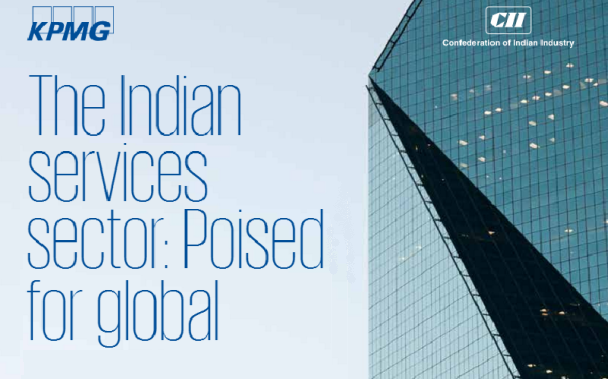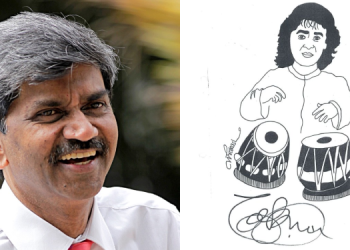New Delhi: The Services Sector is increasingly becoming critical to the development trajectory of a country. The World Bank has found that the sector’s contribution in poverty alleviation is greater than that of agriculture and manufacturing.
The CII-KPMG ‘The Indian services sector: Poised for global ascendancy’ report launched at the second edition of Global Exhibition on Services (GES) highlights that in the year 2014-15, the sector contributed about 61 per cent to India’s GDP, growing strongly at approximately 10 per cent per annum, making India the second fastest growing services economy in the world.
India’s share in global services exports was 3.2 per cent in 2014-15, double that of its merchandise exports in global merchandise exports at 1.7 per cent, placing India in the eighth place currently amongst the top ten exporters of service in the world.
Rajat Wahi, Partner and Head, Consumer Markets, KPMG in India, said, “India’s young demographic profile combined with its rising literacy rate, offers it a significant competitive advantage vis-à-vis other developing economies. Along with the ‘Make in India’ initiative that is striving to boost the manufacturing sector, the Prime Minister has outlined a vision to represent India as a world-class services hub across sectors. Multiple stakeholders need to work cohesively to help achieve this vision.”
He further added, “Technology, innovation and creativity are rapidly redefining the global economy with digitization collapsing distances and transcending borders. In the process, the impact of the services sector is turning out to be manifold and significant. India has pride of place as the fastest-growing service sector nation globally. To keep the momentum going, it is critical that stakeholders, investors and policy-makers are best equipped in strategizing for the future and tapping the best markets globally.”
The publication explores the landscape of key services sectors, such as IT, telecom, tourism, media and entertainment, healthcare, management consulting, logistics and professional services. The report provides a wide ranging view on the current state of the aforementioned sectors in India, highlighting their performance in the past few years, the scenario pertaining to exports, strategies that have fuelled sector growth in the past, the competitive landscape within each sector, government initiatives and lastly, sector expectations from the government to drive growth.
Media and entertainment:
The Indian M&E market size was USD17.1 billion in 2014, which is expected to grow at a rate of 14 per cent annually between 2014-19 to USD33 billion. The sector is the fourteenth largest in the world, and contributes about 1.7 per cent to the country’s GDP. There is a gamut of high quality services available at flexible pricing options in the industry, with some of the major services being content production, animation, game development, post production and VFX, and digital advertising.
Information Technology:
The Information Technology-Business Process Management (IT-BPM) industry is the largest private sector employer in India, employing more than 3.7 million people. The industry is projected to grow at 8.5 per cent in FY2016, from USD132 billion in FY2015 to USD143 billion (excluding e-commerce). IT-BPM exports in FY2016 are estimated at USD108 billion. The major markets for IT software and services exports are the U.S. and the U.K. and Europe, accounting for about 80 per cent of the total IT/ITeS exports.
Tourism services:
The tourism sector’s contribution to GDP was USD125.2 billion in 2014, and is expected to reach USD259 billion in 2025 (accounting to 7.6 per cent of India’s GDP). In 2015, India is estimated to have received USD109.6 billion in revenue from domestic and foreign tourists. India invited around 7.8 million foreign visitors in 2015. Government initiatives, such as e-Visas and expansion of visa-on-arrival facilities are expected to fuel further foreign tourist arrivals.
Healthcare services:
The Indian healthcare sector is forecast to reach USD160 billion in 2017, accounting for about 4.2 per cent of GDP, and is poised to grow to USD280 billion by 2020. With the launch of the ‘Digital India’ initiative, the government is stepping towards digital empowerment. India is expected to be a leader in IT use in healthcare (e-health) by 2019. Indian telemedicine, though in its nascent stage, is showing robust growth at approximately 20 per cent, and is projected to grow from USD8 million in 2012 to approximately USD19 million by 2017.
Accounting and auditing:
India has emerged as a preferred destination for business in the accounting and auditing sector. The sector revenue increased 15 to 17 per cent during the period 2013–14 on account of increasing Foreign Direct Investment (FDI) and growing business activities in the country.
Architecture and engineering:
The production of architectural and engineering services in India was estimated at USD888 million in 2014, and is expected to grow at a CAGR of 14.2 per cent to reach USD1.5 billion by 2018. The sector is expected to grow at 14 per cent per annum, due to expanding urbanisation and increasing government spend. As of 2015, there were approximately 73,000 architects practicing in India. India’s exports in architectural and engineering services were estimated at USD6.9 million in 2014. Exports grew at a significant rate (CAGR of 34 per cent) over the past five years.
Management consultancy:
The global consulting market was estimated to be worth USD234 billion, in 2014. Operations consulting, financial advisory and IT consulting, contributed about 74 per cent of the total market size. Consulting services evolved as one of the fastest growing business services in India; the annual production turnover of the Indian business and management consulting was estimated to be USD3.5 billion in 2014, registering a CAGR of 9.6 per cent during 2010–14. Services exports stood at USD14.4 billion, in FY15.
Legal:
The Indian legal services market expanded by 16 per cent during 2007–12, to reach a value of USD6.8 billion in 2012. The market is expected to grow at a CAGR of 14.9 per cent between 2015 and 2018. India has 600,000 legal professionals in the world, the second-highest after the U.S., with most of them being employed in small firms, across 500 legal practices.
Logistics:
The Indian logistics market, valued at USD123 billion in 2015, is poised to reach approximately USD160 billion by 2018, growing at a CAGR of about 9 per cent. Asset-light models and abundance of manpower are key strengths demonstrated by the Indian logistics sector. The government’s focus to develop infrastructure and capacity, as well as capability in the logistics sector, combined with the use of IT solutions, can help enhance logistics growth as well as exports from the country.
Education:
The education and skill development sector was valued at USD46.7 billion in 2014. There is ample scope for export of services in higher education by attracting foreign students to India. Quality of faculty could be a key differentiator when projecting India as the preferred provider of education. Increasing private participation in the sector could be a key factor to drive further growth.
Maintenance Repair and Operations (MRO):
The Indian civil aviation MRO market stood at an estimated USD1.2 billion in 2015, and is expected to reachUSD4.3 billion by 2025. Government initiatives, such as duty exemption for capital goods and imported materials for repair of ships, reduction of import duty on spare parts, tax benefits, and a liberalised FDI policy are expected to boost investments in the MRO sector. Indian MRO exports reached USD186 million in 2014 from USD77 million in 2012.
Space:
India has launched 40 satellites for 19 countries. The twelfth five-Year Plan includes 25 launch vehicle missions and 33 satellite missions. In FY17, India’s budget estimate towards the space sector is expected to amount to USD1.1 billion

















